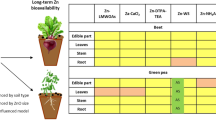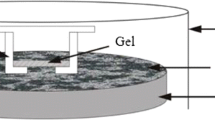Abstract
This study assessed the effect of biosolids applied at rates, 0, 30, 45, and 60 Mg ha−1 on the chemical associations and bioavailability of Cu and Zn in soils from an important agricultural zone of the Metropolitan Region in Central Chile. Three methods were used to determine the bioavailability of Cu and Zn in soils: ryegrass (Lolium perenne) plants, diffusive gradients in thin films (DGT) technique, and Community Bureau of Reference (BCR) sequential extraction. The DGT effective concentration (C E) and sequential extract acid soluble fraction of the BCR extraction (most labile fraction of the soils, normally associated with bioavailability) were compared with total metal concentration in ryegrass plants as a means to compare the chemical and biological measures of bioavailability. Total Zn was higher in comparison to Cu for all treatments. Concentrations were within the limits set by the Chilean regulations for land-applied biosolids. Metals in the control soil were primarily found in the residual fraction of soils. Biosolids application generally decreased this fraction, with a subsequent increase observed mainly in the acid soluble fraction. The contents of Cu and Zn in ryegrass plants increased with increasing rates of biosolids. Comparison of the Cu and Zn content in ryegrass plants with C E, showed a good correlation for Zn. However, the C E for soil Cu was only related to plant Cu for some of the soils studied. Correlation between Zn in ryegrass plants and the labile fraction of Zn as measured by the sequential extraction was excellent, with correlation coefficients >0.9, while for Cu, correlation coefficients were lower.


Similar content being viewed by others
References
Ahumada, I., Gudenschwager, O., Carrasco, M. A., Castillo, G., Ascar, L., & Richter, P. (2009). Copper and zinc bioavailability to ryegrass (Lolium perenne L.) and subterranean clover (Trifolium subterraneum L) grown in biosolid treated Chilean soils. Journal of Environmental Management, 90, 2665–2671.
Almas, A., Lombnaes, P., Song, T., & Mulder, J. (2006). Speciation of Cd and Zn in contaminated soils assessed by DGT-DIFS, and WHAM/Model VI in relation to uptake by spinach and ryegrass. Chemosphere, 62, 1647–1655.
Bacon, J. R., & Davison, C. M. (2008). Is there a future for sequential chemical extraction? The Analyst, 132, 25–46.
Cattani, I., Fragoulis, G., Bocelli, R., & Capri, E. (2006). Copper bioavailability in the rhizosphere of maize (Zeamays L.) grown in two Italian soils. Chemosphere, 64, 1972–1979.
Davison, W., Hooda, P., Zhang, H., & Edwards, A. C. (2000). DGT measured fluxes as surrogates for metal by plants. Advances in Environmental Research, 3, 550–555.
Degryse, F., Smolders, E., Oliver, I., & Zhang, H. (2003). Relating soil solution Zn concentrations to diffusive gradients in thin films measurements in contaminated soils. Environmental Science & Technology, 37, 3958–3965.
DGT–for measurements in waters, soils and sediments. DGT Research Ltd, Lancaster, UK, available at: www.dgtresearch.com, Accessed on: 25 Nov 2006.
DS-4, (2009). República de Chile. Reglamento para el manejo de lodos generados en plantas de tratamiento de aguas servidas.
Harper, M. P., Davison, W., & Tych, W. (1999). Estimation of pore water concentrations from DGT profiles: a modeling approach. Aquatic Geochemistry, 5, 337–355.
Jamali, M. K., Kazi, T. G., Arain, M. B., & Afridi, H. I. (2007). Heavy metals from soi land domestic sewage sludge and their transfer to sorghum plants. Environmental Chemistry Letters, 5, 209–218.
Kovaříková, V., Dočekalová, H., Dočekal, B., & Podborská, M. (2007). Use of the diffusive gradients in thin films technique (DGT) with various diffusive gels for characterization of sewage sludge-contaminated soils. Analytical and Bioanalytical Chemistry, 2007(389), 2303–2311.
Lehto, N. J., Davison, W., Zhang, H., & Tych, W. (2006). Theoretical comparison of how soil processes effect uptake of metals by diffusive gradients in thinfilms and plants. Journal of Environmental Quality, 35, 1903–1913.
Nolan, A. L., Zhang, H., & McLaughlin, M. J. (2005). Prediction of zinc, cadmium, lead, and copper availability to wheat in contaminated soils using chemical speciation, diffusive gradients in thin films, extraction, and isotopic dilution techniques. Journal of Environmental Quality, 34, 496–507.
Nowack, B., Koehler, S., & Schulin, R. (2004). Use of diffusive gradients in thin films (DGT) in undisturbed field soils. Environmental Science & Technology, 38, 1133–1138.
Ruello, M. L., Sileno, M., Sani, D., & Fava, G. (2008). DGT use in contaminated site characterization. The importance of heavy metal site specific behaviour. Chemosphere, 70, 1135–1140.
Sadzawka, A., Carrasco, M. A., Grez, R., Mora, M., Flores, P., & Neaman, A. (2006). Métodos de Análisis Recomendados para Suelos de Chile. Santiago: Instituto de Investigaciones Agropecuarias. Serie Actas INIA-N°34.
Sochaczewski, L., Tych, W., Davison, B., & Zhang, H. (2007). 2D DGT induced fluxes in sediments and soils (2D DIFS). Environmental Modelling and Software, 22, 14–23.
Sonmez, O., & Pierzynski, G. (2005). Assessment of zinc phytoavailability by diffusive gradients in thin films. Environmental Toxicology and Chemistry, 24, 934–941.
Torri, S. I., & Lavado, R. S. (2009). Plant absorption of trace elements in sludge amended soils and correlation with soil chemical speciation. Journal of Hazardous Materials, 166, 1459–1465.
Ure, A. M., Quevauviller, Ph, Muntau, H., & Griepink, B. (1993). Speciation of heavy metals in soils and sediments. An account of the improvement and harmonization of extraction techniques undertaken under the auspices of the BCR of the Commission of the European Communities. International Journal of Environmental and Analytical Chemistry, 51, 135–151.
Walter, I., Martínez, F., & Cala, V. (2006). Heavy metal speciation and phytotoxic effects of three representative sewage sewage sludges for agricultural. Environmental Pollution, 139, 507–514.
Zhang, H., & Davison, W. (1995). Performance-characteristics of diffusion gradients in thin-film for the in situ measurement of trace-metal in aqueous-solution. Analytical Chemistry, 67, 3391–3400.
Zhang, H., Davison, W., Knight, B., & Mc Grath, S. P. (1998). In situ measurement of solution concentration and fluxes of trace metals in soil using DGT. Environmental Science & Technology, 35, 2602–2607.
Zhang, H., Fang-Jie, Z., Bo, S., Davison, W., & Mc Grath, S. P. (2001). A new method to measure effective soil solution concentration predicts copper availability to plants. Environmental Science & Technology, 35, 2602–2607.
Zhao, F. J., Rooney, C. P., Zhang, H., & McGrath, S. P. (2006). Comparison of soil solution speciation and diffusive gradients in thin-films measurement as an indicator of copper bioavailability to plants. Environmental Toxicology and Chemistry, 25, 733–742.
Acknowledgment
The authors thank FONDECYT (Grant 1080357) for financial support.
Author information
Authors and Affiliations
Corresponding author
Rights and permissions
About this article
Cite this article
Ahumada, I., Ascar, L., Pedraza, C. et al. Determination of the Bioavailable Fraction of Cu and Zn in Soils Amended with Biosolids as Determined by Diffusive Gradients in Thin Films (DGT), BCR Sequential Extraction, and Ryegrass Plant. Water Air Soil Pollut 219, 225–237 (2011). https://doi.org/10.1007/s11270-010-0701-9
Received:
Accepted:
Published:
Issue Date:
DOI: https://doi.org/10.1007/s11270-010-0701-9




